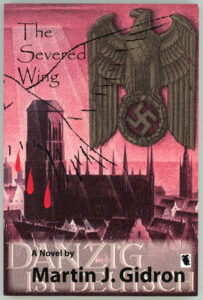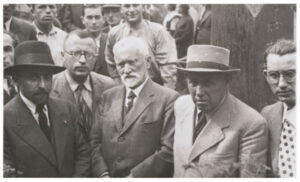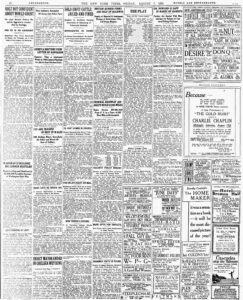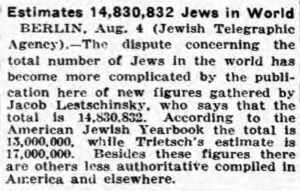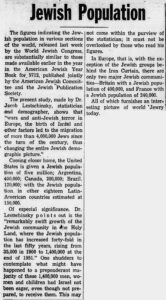As described in Thoughts from The Frontier: Jacob Lestschinsky, Demographer and Scholar, this December 1948 essay – “Jewish Expressions in the U.S.S.R.” – is Lestschinsky’s final writing for the Jewish Frontier.
His previous essays for the journal were:
The Jews of Central Europe – June, 1938
The Fate of Six Million – July, 1938
Jews in Baltic Lands – August, 1938
In Fascist Rumania – September, 1938
Terror in Polish Universities – April, 1939
Though he could draw no definitive conclusions about the future, Lestschinsky was entirely realistic in his appraisal, whether explicit or implied, about the paired impacts of Communism and Stalinism upon the Jews of the Soviet Union, whether individually or collectively.
______________________________
The Jewish children of the USSR
are brought up with no knowledge whatever of their people’s history,
and acquire through their education no personal bond with its collective destiny.
* * * * * * *
…the reader is amazed to see how the Yiddish language
has been turned into an implement for estranging Jews from their past,
from Jews elsewhere in the world, and from all hope of a Jewish future.
The vocabulary of these productions is dry, wooden, destitute of any values or conceptions
that might convey overtones out of Jewish history and Jewish destiny.
Nowhere does one encounter such words as Exile, Redemption, Messiah, Destruction,
the prophet Elijah, the prophets generally,
Moses, the Temple, Jerusalem, Eretz Israel,
the patriarchs Abraham, Isaac, and Jacob,
Bible, Talmud, Shulkhan Arukh, Kabbalah,
Sabbath, the festivals, Rosh Hashanah, Yom Kippur, Tishah B’Av, Simkhas Torah,
or any of the myriad expressions that lend color to the Yiddish language,
awakening time-honored memories and stirring up immemorial hopes.
* * * * * * *
… there is not a single piece about either of the two epochal events
that have dominated Jewish writing elsewhere,
in all tongues,
and in all forms of literature and journalism:
nothing about the catastrophe of European Jewry,
and nothing about the fight for the State of Israel.
* * * * * * *
… a poet like David Hofstein, who once wrote with such poignant feeling, in his own way,
about the Holy Spirit in Exile,
joining in the chorus of muteness,
and saying not a word about the Jewish tragedy,
though he writes about everything else under the sun – not excluding the panergyrics to Stalin.
* * * * * * *
“The sun itself might have been quenched,
Chocked by blood and ash and loam,
Had not the blooming of my home
The brilliant orb with radiance drenched.
For Stalin’s strength and Stalin’s will
Mine earth irradiate to its heart.”
______________________________
Jewish Expressions in the USSR
December, 1948
THE CULTURE which sustains nationality among most peoples has almost the power of natural necessity. Without taking any special pains, a Frenchman from the day of his birth is imbued with potent influences of his national tradition and contemporary environment. Jews are not in the fortunate position. The traditions and environment of other nationalities affect the Jews with almost the force of natural necessity; and to sustain his own cultural heritage and his sentiment of ethnic “belongingness,” he must apply himself deliberately to the maintenance of the Jewish language, schools, and literature.
What is the situation of Soviet Jewry in this respect? There are hardly any Jewish schools. Even those in Biro-Bidjan cannot pretend to constitute a school system in which all Jewish children would be educated in the Yiddish language. The Jewish children of the USSR are brought up with no knowledge whatever of their people’s history, and acquire through their education no personal bond with its collective destiny. Thus, is there is any element of culture cementing the Jewish group in the USSR today and holding out hope for their future as a Soviet nationality, it can only be the literature produced there in the Yiddish language. It is appropriate, therefore, to ask ourselves whether Yiddish literature, of the type that is being created in the USSR, makes for continuity, or if it makes precisely for the disintegration of Jewish ethnic existence.
I HAVE before me six Yiddish volumes recently issued in the USSR – five issues of the review Heimland, published in Moscow, and one volume of the review Der Shtern, published in Kiev. The latter book – 121 pages of stories, essays, and poetry – one approaches with the highest anticipation. Kiev, the capital of the Ukraine, had in pre-way days a deeply-rooted Jewish community with strong traditions, one that had developed unique institutions, and today, according to Soviet sources, Kiev is the center of a region in which there should be a resettled Jewish population of around a million.
Turning to this review first, the reader is amazed to see how the Yiddish language has been turned into an implement for estranging Jews from their past, from Jews elsewhere in the world, and from all hope of a Jewish future. The vocabulary of these productions is dry, wooden, destitute of any values or conceptions that might convey overtones out of Jewish history and Jewish destiny. Nowhere does one encounter such words as Exile, Redemption, Messiah, Destruction, the prophet Elijah, the prophets generally, Moses, the Temple, Jerusalem, Eretz Israel, the patriarchs Abraham, Isaac, and Jacob, Bible, Talmud, Shulkhan Arukh, Kabbalah, Sabbath, the festivals, Rosh Hashanah, Yom Kippur, Tishah B’Av, Simkhas Torah, or any of the myriad expressions that lend color to the Yiddish language, awakening time-honored memories and stirring up immemorial hopes.
The content of these writings is equally strange: not a single picture from specifically Jewish life. One might conclude that there is no specifically identifiable context of Jewish life to become the subject of literature. But even among the protagonists of these stories there is none who shows any trace of an individual Jewish quality, of specific Jewish concerns or experiences.
TAKING all six volumes together, there is not a single piece about either of the two epochal events that have dominated Jewish writing elsewhere, in all tongues, and in all forms of literature and journalism: nothing about the catastrophe of European Jewry, and nothing about the fight for the State of Israel. There is an occasional reference, to be sure, to one or another Jewish protagonist’s having lost his father or mother, but these facts are mentioned in such a markedly dry and off-hand manner that the impression created is of a purely individual misfortune, a mere incident. That this extraordinary silence is concerted, not accidental, becomes obvious enough when one sees a poet like David Hofstein, who once wrote with such poignant feeling, in his own way, about the Holy Spirit in Exile, joining in the chorus of muteness, and saying not a word about the Jewish tragedy, though he writes about everything else under the sun – not excluding the panergyrics to Stalin.
But if the slaughter of the Jews is occasionally referred to, in individual cases, there is utter blankness about Israel – verboten! Material about this new state, with its 700,000 Jews through whom Soviet policy may hope to score some points in its conduct of international affairs – this is an export commodity for the back pages of Einikeit, and occasionally for the front pages, when it can serve to embarrass England and the United States among Jews abroad. But, in poetry, criticism, or belles lettres – not a word. Israel is prohibited from entering the hearts of Soviet Jewry – at least through the medium of Yiddish literature.
Well, then, can one find anywhere in the reviews a piece about the Jews in any other country of the world? Not that, either. Even the Jews of Poland, Rumania, and Hungary – all countries with Communist governments – do not exist! No discussion in a Yiddish review of the very interesting Yiddish literature and Yiddish press that has arisen in neighboring, Communist Poland! The Soviet Jew must be purely and strictly Soviet, hermetically protected against any contact with Jewish culture beyond the border.
Let us overlook this idiosyncrasy and ask – What about Jewish culture in the Soviet Union itself? Nowhere any article on Jewish education, or any specific Jewish problem in the USSR! No cursory or incidental mention by any character in a story of the existence of matters of specifically Jewish interest.
Most revealing is the way these reviews portray the Jew in his contact with his non-Jewish neighbors. In the Ukraine, the local non-Jewish population was responsible for the slaughter of hundreds of thousands of Jews. In Byelo-Russia the number was smaller because fewer Jews lived there, but in proportion the crime was non smaller. Did this orgy of murder by the neighbors of the Ukrainian and Byelo-Russian Jews leave any traces in the relations between Jew and non-Jew? Not a trace; current Soviet Yiddish literature is silent on this point. Rather, it is far from silent: it paints such an idyllic picture of love between Jew and non-Jew, that we should all celebrate the arrival of Messianic times – lambs lying down with lions, swords forged into ploughshares. At least, in Yiddish belles lettres in the Soviet Union all these prophecies have been realized. It is painful to read in Yiddish, in one’s own tongue, such a sycophantically aggressive wooing of those who so recently stepped their hands in Jewish blood. The harmony portrayed between Jew and Gentile in the Ukraine and Byelo-Russia is not a mere cooperation in common projects; it is intimate and personal – not only no difference of opinion, but no difference of feeling. Before such an overweening, offensive of love, the other party must certainly yield – until the next wave of pogroms…
According to this literature, there can hardly be a dozen guilty men in all Ukraine and Byelo-Russia. Even the though the life portrayed is largely, even mainly, lived in contact with Gentiles, rarely does one come across an anti-Semite, let alone a Jew-killer. All saints! The chauvinists and reactionaries who murdered the Jews – all gone. Are Soviet Jews compiling documentary materials on those distant events of 1941 to 1944 when certain obscure ruffians, strangers to the spirit of the Soviet Ukraine and Byelo-Russia, destroyed a matter of a million Jews or so in such remote places as Kiev and Berditchev, Odessa and Kharkov, Minsk and Gomel? We do not know. About three years ago, there were some references to such a project, but they quickly died down. Now, one hears no more about it. But the Yiddish belles letters of 1948 have quite other concerns than to evoke melancholy feelings among Jews because of a few exceptional Ukrainians and Byelo-Russians who, long, long ago, in 1941-1944, were misled by the Germans and took a small part in the extermination of the Jews. The theory of this literature is that all the Ukranians and Byelo-Russians whom Jews meet in kolkhoz and factory, in offices and in institutions, are too kind and pure to harm a hair on a Jew’s head; most of them, indeed, saved Jews from death in those old, unhappy days.
TO BE more specific, let us begin with no less a writer than the novelist David Bergelson, the author of Nokh Alemen and and Avrum Vokzal, in which Jewish nostalgia and Jewish individuality, the decay of ancient values and traditions, and anxiety over the clouded future of Jewishness achieve so fine an expression. That David Bergelson is no longer recognizable in the Soviet author writing on “Jewish” themes in Yiddish today. The fabula of his new novel, which is being printed serially in Heimland, concerns an American Jewish professor of Russian origin who journeys to Biro-Bidjan to seek out the sweetheart of his youth. Meanwhile, he observes the marvelous development of the new region, and the new types of Jews who live there. And they are indeed new types, particularly for the old Bergelson nothing identifiable as Jewish, beyond the name, but each one a true copy of the standard Soviet citizen. Their achievements are not celebrated as Jewish triumphs nor their setbacks grieved at as Jewish defeats, but in all respects their project is presented as one of the great USSR, directly.
What sort of poetry is printed in the Ukranian Yiddish review? Here certainly, in this most personal form of expression and in the journal of one of the densest Jewish populations, one might hope for a more intimate Jewishness. The first poem in the review, by Khanne Levin, is entitled “Our Sun,” and includes lines which read roughly as follows:
“The sun itself might have been quenched,
Chocked by blood and ash and loam,
Had not the blooming of my home
The brilliant orb with radiance drenched.
For Stalin’s strength and Stalin’s will
Mine earth irradiate to its heart.”
For the rest, the poem is a bouquet of curses for England and America and a shower of praises upon the sole savior of a world menaced by fascism – that is, Stalin’s Russia. The opening lines and some additional verses are sufficiently illustrative:
“You there, choking on the venom
Of hatred for my land,
‘Gainst whom do you now raise a hand?”
“For all that turns unto the light
Must go with us, does go with us.”
The same poetess contributes a poem on practically the same theme, entitled “For Human Joy”. Its joyous refrain runs as follows:
“O, blossom forth with joy and glee
For the happy dream of humanity!
And a bullet for him who first lets fly
In all the world a battle-cry!”
After this political poetry, we find a long story, the major item in the review, laying down, so to speak, its economic program. The story contains a romantic tale which we may ignore, because it is a minor and unilluminating element. The hero of the story is Ephraim, a Jew who had come back after five years of war to find his wife and children lost (how lost, is not explained), and, without taking even a few days to rest from the war effort, went back at once to find his old job in the tractor station, throwing himself into the work with unbounded energy. An older version of Ephraim is Kovel Gedalya, one other Jewish worker in the station. When a Ukrainian worker, Danilo, comes to work late once, because he is tired, Kovel Gedalya speaks as follows: “Well, Danilo, do you think Comrade Stalin doesn’t work day and night? To carry through such a war, a trifle. He was at all the fronts! Everywhere, he had to see things personally. He even came to us in the Urals, a mere trifle! And don’t forget, that he’s not so young anymore; but for him nothing is too hard – work is work. Now then, Danilo, get behind that hammer!” (p. 27) These two figures exemplify the function of the Jew in the Soviet economy, as portrayed by Soviet Yiddish letters – to stimulate effort, to be tireless, to labor unremittingly who brain and brawn, and to urge on others to do likewise. The heroes are two Jews among many non-Jews who set the dominant tone of their lives. But even when the two meet alone, or speak to the two Jewish women in the story, both of them from Ephraim’s hone-town, (the older one lost her husband and child, and the other, Malkah, whom Ephraim later marries, had not both her parents) they never speak as Jews, never mentioned that their personal tragedies might have something to do with their being Jews, or that there might be some among their non-Jewish fellow-workers who participated in the slaughter. In the climatic love scene between Ephraim and Malkah, they talk about “ordering new machines, shops, setting up workers’ clubs as light and airy as palaces.” (p. 49)
Other items in the review are “Spring 1948” by Moshe Pinchevsky, which hopes in verse for “thirty hundredweight” of grain her hectare and P. Kritichansky sings about “axes roaming the mighty woods,” and girls preparing “dams to cut in the forest.” This poet is also represented by two other poems, “By the River” and “In the Village,” in the latter of which “a cow stands thoughtfully still.”
We come, thus, to a story by a well-known Soviet author, H. Blaustein, bearing the intriguing title “His Dream.” What is the “dream” of a Jewish scientist in the Soviet Union? He dreams of success in breeding experiments with rabbits. The “resolute laborer of science,” David Vitkin, is afflicted momentarily with doubts concerning an experiment going on in a Soviet institute, but he summons up he reserves of resolution and labors on doggedly until he achieves his goal! There is a complication concerning a manuscript by an outstanding Soviet scientist who had been killed by the Germans, attempting to steal his discoveries. David finds the manuscript and completes the experiment, realizing the dream of the martyred Soviet genius.
THIS selection is representative of the Jewish quality of all the other stories and poems in the collection. But one additional piece deserves special attention. The author, Itzik Kipnis, is exceptional in that he was charged a while ago with chauvinism, and this story evidently represents an attempt at self-rehabilitation. He tells of Herschel Mechanik and his wife, Idda, who decide to adopt an orphan – “The government will not neglect them, but aren’t we also under an obligation?” says Herschel. In the orphanage, their enthusiasm rises and the childless couple return with two children. As to the little girl, it is not certain whether she is Jewish or Christian – her name is Zoya – but the boy’s name is Kostya, and his father was called Konstantin Pavlovitch Netchiporuk. And the director of the orphanage who entrusted these children to the Jewish couple is named Anna Antonovna. It is no doubt praiseworthy that a Jewish couple should extend its parental care to Soviet orphans without discrimination as to religion or nationality, but should not one of the parties involved be concerned as to the education of the children? Obviously not. They will be educated in an international spirit – to put it more concretely, in a Russian or even Ukrainian milieu. Herschel Mechanik’s house preserves none of the atmosphere of Jewish tradition, has no trace of Jewish individuality, no sign that it is not a Russian or Ukrainian home. Thus, Anna Antonovna, whose sentiments and loyalties are surely, if not those of Christian religion, at least those of Russian nationality, doesn’t even think it necessary to raise the question how Kostya, the son of Konstantin Pavlovitch Netchiporuk, will be brought up in the home of Herschel Mechanik.
The light this story casts on the depletion and lifelessness of Jewish culture in the USSR needs no further commentary. It is worth pointing, however, that Netchiporuk is very closely related indeed to the bloody Bogdan Khmelnitsky of seventeenth century fame, and the posterity of that notorious ancestor demonstrated very plainly only a few years ago how true they remain to the traditions of their national hero.




